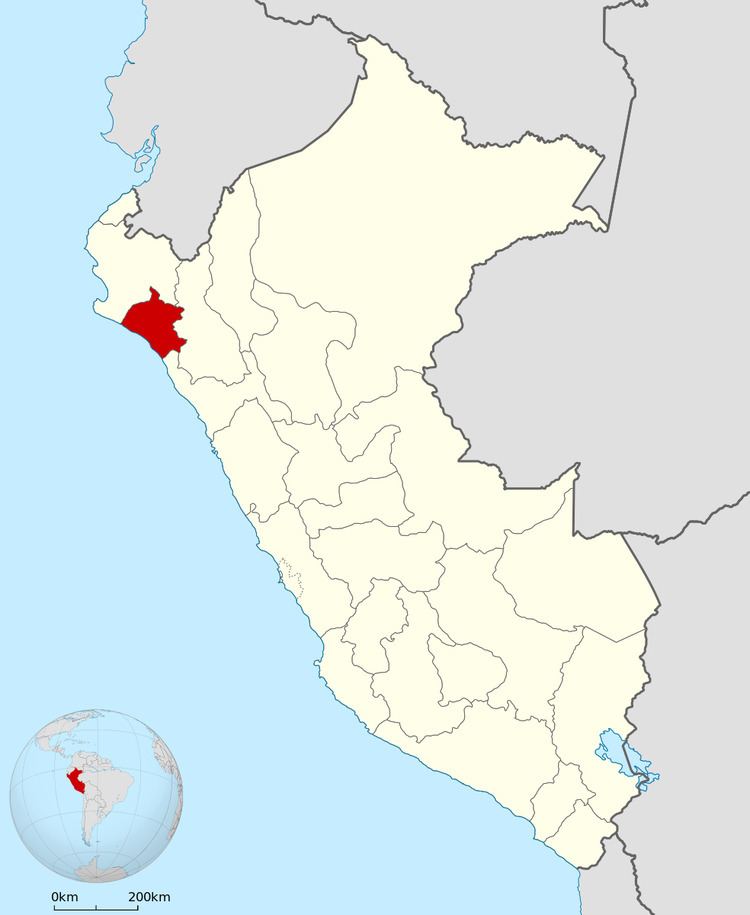Country Peru Highest elevation 3,078 m (10,098 ft) UBIGEO 14 | Capital Chiclayo Lowest elevation 0 m (0 ft) | |
 | ||
Subdivisions 3 provinces and 38 districts | ||
Lambayeque is a region in northwestern Peru known for its rich Moche and Chimú historical past. The region's name originates from the ancient pre-Inca civilization of the Lambayeque.
Contents
- Map of Lambayeque Peru
- Etymology
- Geography
- Political division
- History
- Places of interest
- Music from Lambayeque
- References
Map of Lambayeque, Peru
Etymology
The name Lambayeque is a Spanish derivation of the god Yampellec, said to have been worshipped by the first Lambayeque king, Naymlap. The Spanish gave the name to the early people.
Geography
The territory of the Lambayeque Region is made up of wide plains irrigated by rivers from the Andes; in most of the arid area, irrigation is needed to support any farming. The fertile river valleys produce half of the sugar cane crop of Peru. In addition, Lambayeque and the Piura Region provide most of the rice crops consumed in Peru.
Increased agricultural harvest is expected with completion of the Olmos Transandino Project. The water supply project will transfer up to 2 billion m3 annually of water from the Huancabamba River in the Cajamarca Region east of Lambayeque.
In the smaller scale farming of earlier centuries, the Olmos Carob Tree Forest supported goat herds that fed on carobs. The fine goatskins were tanned to create the fine, pale, leather known as "cordoban" or "cordovan", from the Spanish town of Córdoba, where the process was developed. Goat fat was used to make soap.
There are two small islands off the Pacific coast of the Lambayeque Region: Lobos de Afuera, and Lobos de Tierra; there was a dispute with the Piura Region over ownership of the latter island.
The region is bordered by the Piura Region on the north, the Cajamarca Region on the southeast, the La Libertad Region on the south and the Pacific Ocean on the west.
Political division
The region is divided into 3 provinces (provincias, singular: provincia), which are composed of 38 districts (distritos, singular: distrito). The provinces, with their capitals in parentheses, are:
History
Legend tells that in ancient times, a great float of balsa rafts arrived at the beaches of the existing San José cove. Formed by a brilliant cortege of nine foreign warriors, this float was led by a man of great talent and courage, named Naymlap, the mythical founder of the first northwest civilization.
Among the descendants of Naylmlap were the Moche and the Chimú, the latter builders of a great civilization forged in Lambayeque before being conquered by the later Inca Empire. The Chimú grew to acquire a notable state parallel to the Inca. The Chimú moved their capital to the northern area, establishing great urban centers there. They were great farmers, textile experts and, wonderful goldsmiths, with extraordinary works in gold.
The Inca conquest of what today is Lambayeque, lasted almost four decades. Pachacuti, Tupac Inca Yupanqui and Huayna Cápac, successively, ruled during the process.
In the 16th century, the Spaniard leader Francisco Pizarro took his conquistadors across the region on the way to Cajamarca to conclude the defeat of the Inca empire. He was amazed by the gold exposed in vases and utensils.
During Colonial times, a rivalry started between the people of the towns of Lambayeque and Santiago de Miraflores de Saña. The reason of the conflict was the opulence in which the latter lived, even provoking the greed of pirates. A flood in 1720, however, destroyed Saña and marked the end of a flourishing city.
The people of Lambayeque followed Juan Manuel Iturregui as their leader in the struggles for emancipation and independence from Spain. He spread the libertarian ideas and helped get arms for the cause.
Places of interest
Music from Lambayeque
The most famous composer from Lambayeque was Luis Abelardo Nuñez, born in Ferreñafe on 22 November 1926. His songs are among the most popular ones in Peruvian music. These included the following:
